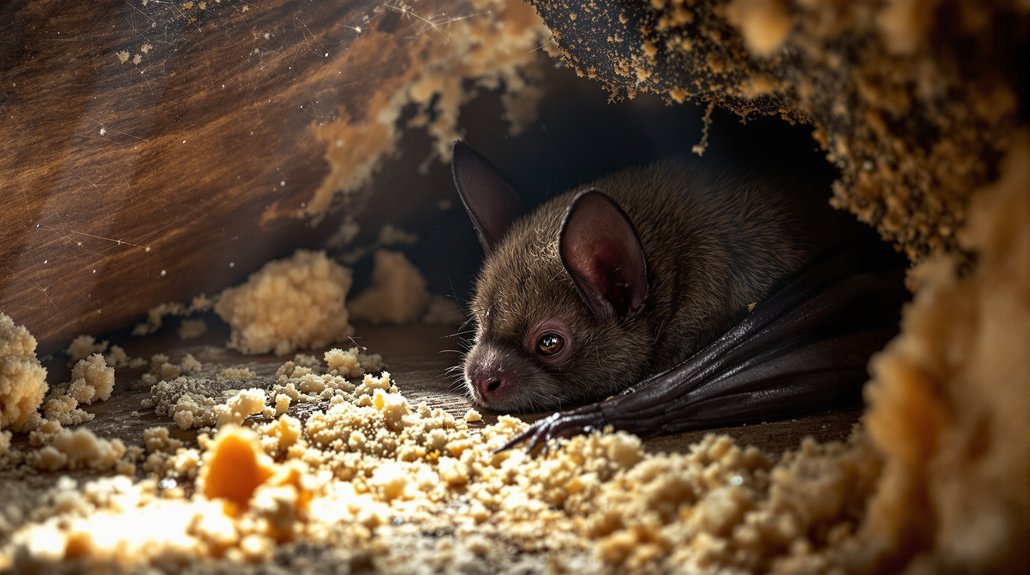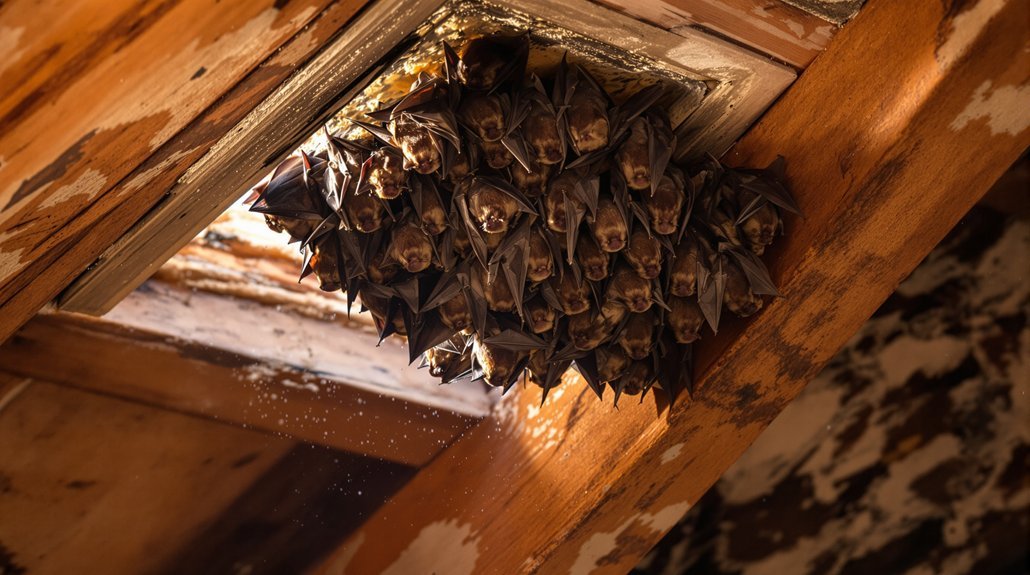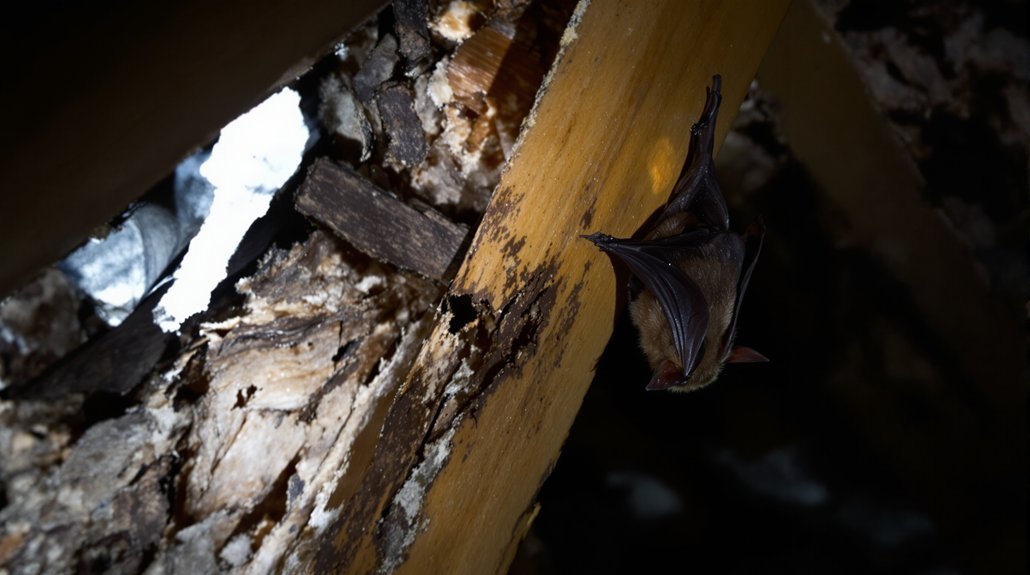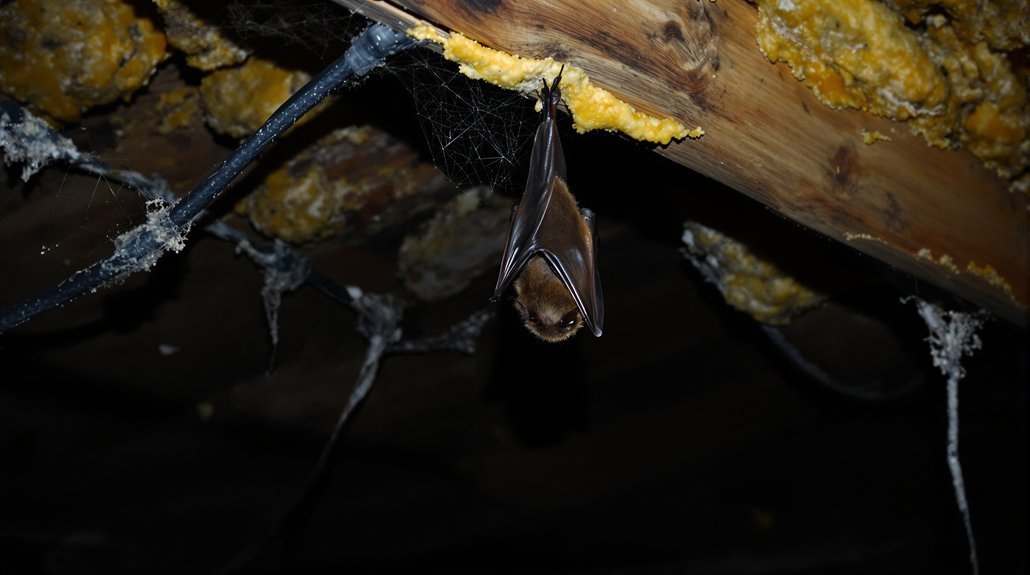Bats can live in attics in Des Moines for multiple seasons if the conditions are favorable. Their lifespans typically range from 10 to 30 years, depending on the species and environmental factors. If they find suitable insulation and shelter, they may stay long-term. Bats can return each season if not removed. Understanding their habits and impacts can help manage their presence effectively. More insights about bat management and conservation are available for those interested.
Key Article Highlights
- Bats can roost in attics for multiple seasons or years if the environment remains suitable and undisturbed.
- Their presence is often influenced by the availability of food and shelter in the attic.
- Seasonal migration may lead to recurring infestations, with bats returning to the same roost annually.
- Proper habitat management and exclusion techniques can significantly reduce the duration of bat occupancy in your attic.
- Regular attic inspections are essential for early detection and management of bat presence.
Understanding Bat Lifespan

Although bats are often seen as mysterious creatures, their lifespan is relatively straightforward. Bats typically live between 10 to 30 years, depending on the species. Their longevity can be influenced by factors such as diet and migration patterns. A healthy bat diet, rich in insects or fruit, supports a longer life. Additionally, bats that migrate often face challenges such as climate changes and food availability, which can affect their survival. During migration, the need for energy and resources increases, impacting their overall health. Understanding these factors is essential for those concerned about bats in their attics. In Des Moines, knowing how bat lifespan works can help residents manage their expectations and responses to these nocturnal visitors. Bat lifespan varies significantly among species and environmental conditions. Proper exclusion and habitat management can also influence how long bats survive in human structures.
Common Bat Species in Des Moines

Des Moines is home to several common bat species. These bats often seek out specific habitats, such as attics and wooded areas. Understanding these species and their preferences can help homeowners manage bat encounters effectively.
Local Bat Species
In the heart of Iowa, several bat species can be found, each playing an indispensable role in the local ecosystem. Understanding these species helps in recognizing their habits, including bat migration and roost selection. The following are common bat species in Des Moines:
- Little Brown Bat – Known for its small size and adaptability, this species often roosts in buildings.
- Big Brown Bat – Larger than the Little Brown Bat, it prefers attics and other sheltered areas.
- Eastern Red Bat – This species is often found in trees, showcasing a colorful appearance.
- Hoary Bat – A solitary bat, it migrates long distances and enjoys forested habitats.
Recognizing these species can aid in effective wildlife management and conservation efforts.
Habitat Preferences
Bats in Des Moines exhibit specific habitat preferences that influence their roosting and foraging behaviors. Common species, like the Little Brown Bat, prefer attics and tree hollows for roosting. These bats are known for their migration patterns, often traveling to warmer areas during winter months. Their feeding habits are primarily insectivorous, with a preference for moths and beetles. Bats tend to roost in locations that provide protection from predators and harsh weather. Additionally, they seek areas near water sources, as these attract their preferred prey. Understanding these habitat preferences can help homeowners manage bat populations effectively and promote coexistence. By knowing where bats thrive, one can better address issues related to their presence in attics.
Factors Influencing Bat Longevity

Although various factors play a role in determining bat longevity, environmental conditions and diet are among the most significant. Bats that thrive in favorable habitats often live longer. Their roost preferences, such as choosing safe and stable locations, impact their survival. Additionally, diet plays a vital role, as bats that have access to plentiful food sources tend to be healthier and live longer lives.
Key factors influencing bat longevity include:
- Environmental Conditions: Temperature and weather patterns affect their health.
- Diet Quality: Availability of nutritious food impacts growth and reproduction.
- Roost Preferences: Safe and secure roosts help in avoiding predators.
- Bat Migration: Successful migration to warmer areas can enhance lifespan.
Signs of a Bat Infestation
A bat infestation can often be identified by several telltale signs. Homeowners may notice a strong odor resembling ammonia, which is associated with bat droppings. Additionally, small dark droppings can accumulate near entry points, revealing their presence. Sounds such as squeaks or rustling may indicate activity, as bats use echolocation to navigate and find food. Vampire folklore often exaggerates the fear of bats, but these creatures are generally harmless. However, signs of infestation should not be ignored. Observing bats flying around dusk or finding them inside living spaces are clear indicators of an issue. Prompt action is essential to manage the situation effectively and prevent further complications.
Impact of Bats in Your Attic
What happens when bats take up residence in an attic? Their presence can lead to several impacts that homeowners should consider. Understanding these effects is vital for managing the situation effectively.
- Noise: Bats are active at night, creating sounds that can disturb sleep.
- Droppings: Bat guano can accumulate, leading to health risks and odors.
- Insulation Damage: Their nesting habits may damage insulation and other materials.
- Bat Diet: Bats consume insects, which can reduce pest populations but may attract other wildlife.
Additionally, bats may migrate seasonally, potentially leading to recurring infestations. Awareness of these impacts can aid homeowners in making informed decisions regarding bat presence in their attics.
Safe Removal and Exclusion Methods
Safe removal and exclusion methods are important for managing bats in attics. This includes using humane trap techniques to collect the bats, sealing entry points to prevent future access, and implementing post-removal prevention strategies. These steps help guarantee both the safety of the bats and the integrity of the home.
Humane Trap Techniques
When dealing with bats in an attic, humane trap techniques offer effective solutions for removal and exclusion. Many cultural myths suggest bats are dangerous, but they are often harmless and beneficial. To facilitate a safe and humane approach, consider the following techniques:
- Use Bat-Specific Traps: These traps are designed to capture bats without harming them.
- Monitor Noise Disturbances: Identify the times when bats are most active, allowing for targeted trapping efforts.
- Placement of Traps: Set traps near entry points to increase the chances of capture.
- Release in Safe Areas: After trapping, relocate bats to a suitable environment away from residential areas.
These methods promote a humane resolution while respecting the ecological role of bats.
Sealing Entry Points
Sealing entry points is a essential step in preventing bats from returning to an attic. Bats can enter through small gaps and cracks, often found near rooflines or vents. It is imperative to carefully inspect the attic and seal these openings with durable materials. This may include using caulk, steel mesh, or other suitable barriers. Discarded clothing can also serve as a temporary deterrent, as its smell may discourage bats from coming back. Additionally, checking attic insulation for disturbances can help identify potential entry points. After sealing, it is imperative to monitor the attic regularly to ensure no new entry points appear. Proper sealing not only protects the attic but also aids in maintaining a safe and healthy environment.
Post-Removal Prevention
After bats are removed from an attic, it is crucial to focus on prevention methods to guarantee they do not return. Implementing the right strategies can protect the home from future bat migration and ensure effective attic insulation.
- Seal All Entry Points: Inspect for gaps and cracks, sealing them to prevent re-entry.
- Install Bat Houses: Encourage bats to roost elsewhere by providing designated habitats.
- Maintain Attic Insulation: Make certain insulation is in good condition, as bats may be attracted to warm, insulated areas.
- Regular Inspections: Periodically check the attic for signs of bats or potential entry points.
The Importance of Bat Conservation
Although often misunderstood, bats play an essential role in maintaining healthy ecosystems. They are critical for controlling insect populations, as many species consume vast amounts of insects each night. This natural pest control helps farmers and reduces the need for chemical pesticides. Additionally, bat migration contributes to the pollination of plants and the dispersal of seeds, supporting biodiversity. However, it is important to recognize the rabies risks associated with bats. While the chance of transmission is low, awareness and education about these risks are essential for public safety. By practicing bat conservation, communities can protect these beneficial creatures while minimizing potential health concerns, ensuring a balanced ecosystem for future generations.

